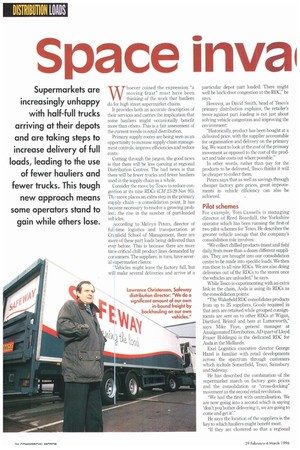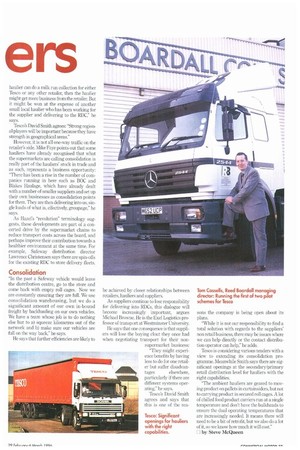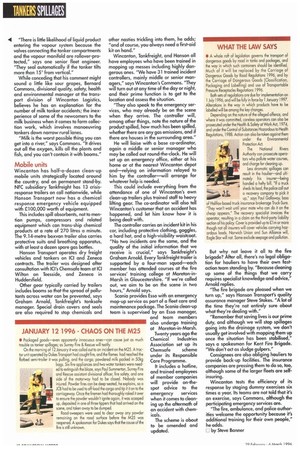Space inva
Page 38

Page 39

Page 42

If you've noticed an error in this article please click here to report it so we can fix it.
Supermarkets are increasingly unhappy with half-full trucks arriving at their depots and are taking steps to increase delivery of full loads, leading to the use of fewer hauliers and fewer trucks. This tough new approach means some operators stand to gain while others lose.
hoever coined the expression "a moving feast" must have been thinking of the work that hauliers do for high street supermarket chains.
It provides both an accurate description of their services and carries the implication that some hauliers might occasionally benefit more than others. This is a fair assessment of the current trends in retail distribution.
Primary supply routes are being seen as an opportunity to increase supply chain management controls, improve efficiencies and reduce costs.
Cutting through the jargon, the good news is that there will be less queuing at regional Distribution Centres. The bad news is that there will be fewer trucks and fewer hauliers used in the supply chain as a whole.
Consider the move by Tesco to reduce congestion at its nine RDCs (CM 23-29 Nov 95). Th move places an extra step in the primary supply chain—a consolidation point. It has become necessary to resolve a growing problen : the rise in the number of part-loaded vet ides.
According to Melvyn Peters, director of fult-time logistics and transportation at Cr E nfield School of Management, there are more of these part loads being delivered than ever before. This is because there are more tine-critical chill product lines demanded by cor sumers. The suppliers, in turn, have several 5upennarket clients:
'Vehicles might leave the factory full, but will make several deliveries and arrive at a particular depot part loaded. There might well be back-door congestion at the RDC," he says.
However, as David Smith, head of Tesco's primary distribution explains, the retailer's move against part loading is not just about solving vehicle congestion and improving the environment: "Historically, product has been bought at a delivered price, with the supplier accountable for organisation and delivery on the primary leg. We want to look at the cost of the primary movement as opposed to the cost of the product and take costs out where possible."
In other words, rather than pay for the products to be delivered, Tesco thinks it will be cheaper to collect them.
Peters says that as well as savings through cheaper factory gate prices, great improvements in vehicle efficiency can also be achieved.
Pilot schemes
For example, Tom Cassells is managing director of Reed Boardall, the Yorkshire operator which has been running the first of two pilot schemes for Tesco. He describes the greater vehicle useage that the company's consolidation role involves: "We collect chilled products (meat and fish) daily from more than a dozen different suppliers. They are brought into our consolidation centre to be made into specific loads. We then run these to all nine RDCs. We are also doing deliveries out of the RDCs to the stores once the vehicles are unloaded," he says.
While Tesco is experimenting with an extra link in the chain, Asda is using its RDCs as the consolidation points:
"The Wakefield RDC consolidates products from up to 25 suppliers. Goods required in that area are retained while grouped consignments are sent on to other RDCs at Wigan, Dartford, Bristol and here at Luttenvorth," says Mike Faye, general manager at Amalgamated Distribution. AD (part of Lloyd Fraser Holdings) is the dedicated RDC for Asda in the Midlands.
Exel Logistics executive director George Hazel is familiar with retail developments across the spectrum through customers which include Somerfield, Tesco, Sainsbury and Safeway.
He has described the combination of the supermarket march on factory gate prices and the consolidation or "cross-docking" movement as the second retail revolution.
"We had the first with centralisation. We are now going into a second which is saying • 'don't you bother delivering it, we are going to come and get it'."
He says the location of the suppliers is the key to which hauliers might benefit most.
"If they are clustered so that a regional haulier can do a milk run collection for either Tesco or any other retailer, then the haulier might get more business from the retailer. But it might be won at the expense of another small local haulier who has been working for the supplier and delivering to the RDC," he says.
Tesco's David Smith agrees: "Strong regional players will be important because they have strength in geographical areas."
However, it is not all one-way traffic on the retailer's side. Mike Faye points out that some hauliers have already recognised that what the supermarkets are calling consolidation is really part of the hauliers' stock in trade and as such, represents a business opportunity: "There has been a rise in the number of companies running in here such as BOC and Blakes Haulage, which have already dealt with a number of smaller suppliers and set up their own businesses as consolidation points for them. They are then delivering into us, single loads of what is, effectively, groupage," he says.
As Hazel's "revolution" terminology suggests, these developments are part of a concerted drive by the supermarket chains to reduce transport costs across the board, and perhaps improve their contribution towards a healthier environment at the same time. For example, Safeway distribution director Lawrence Christensen says there are spin-offs for the existing RDC to store delivery fleets.
Consolidation
"In the past a Safeway vehicle would leave the distribution centre, go to the store and come back with empty roll cages. Now we are constantly ensuring they are full. We use consolidation warehousing, but we do a significant amount of our own in-bound freight by backhauling on our own vehicles. We have a team whose job is to do nothing else but to a) squeeze kilometres out of the network and b) make sure our vehicles are full on the way back," he says.
He says that further efficiencies are likely to be achieved by closer relationships between retailers, hauliers and suppliers.
As suppliers continue to lose responsibility for delivering into RUCs, this dialogue will become increasingly important, argues Michael Browne. He is the Exel Logistics professor of transport at Westminster University.
He says that one consequence is that suppliers will lose the buying clout they once had when negotiating transport for their nonsupermarket business: They might experience benefits by having less to do for one retailer but suffer disadvan tages elsewhere, particularly if there are different systems operating," he says.
Tesco's David Smith agrees and says that this is one of the rea sons the company is being open about its plans.
"While it is not our responsibility to find a total solution with regards to the suppliers' non retail business, there may be issues where we can help directly or the contact distribution operator can help," he adds.
Tesco is considering various tenders with a view to extending its consolidation programme. Meanwhile Smith says there are significant openings at the secondary/primary retail distribution level for hauliers with the right capabilities.
"The ambient hauliers are geared to moving product on pallets in curtainsiders, but not to carrying product in secured roll cages. A lot of chilled food product carriers run at a single temperature and don't have the bulkheads to ensure the dual operating temperatures that are increasingly needed. It means there will need to be a bit of retrofit, but we also do a lot of it, so we know how much it will cost."
Fl by Steve McQueen
"There is little likelihood of liquid product entering the vapour system because the valves connecting the tanker compartments and the vapour manifold are rollover-protected," says one senior fleet engineer. "They seal automatically if the tanker tilts more than 15° from vertical."
While conceding that his comment might sound a little like sour grapes, Bernard Commons, divisional quality, safety, health and environmental manager at the transport division of Wincanton Logistics, believes he has an explanation for the number of milk tanker accidents; the inexperience of some of the newcomers to the milk business when it comes to farm collection work, which involves manoeuvring tankers down narrow rural lanes.
"Milk is the worst possible thing you can get into a river," says Commons. "It drives out all the oxygen, kills all the plants and fish, and you can't contain it with booms."
Mobile units
Wincanton has half-a-dozen clean-up mobile units strategically located around the country, and on permanent stand-by. NFC subsidiary Tankfreight has 13 crisisresponse trailers on call nationwide, while Hanson Transport now has a chemical response emergency vehicle equipped with £100,000 worth of equipment.
This includes spill absorbents, not to mention pumps, compressors and related equipment which can trans-ship chemical products at a rate of 270 litres a minute. The 9.14-metre boxvan trailer also carries protective suits and breathing apparatus, with at least a dozen spare gas bottles.
Hanson Transport operates dry freight vehicles and tankers on ICI and Zeneca contracts. The trailer was designed after consultation with ICI's Chemsafe team at ICI Wilton on Teesside, and Zeneca in Huddersfield.
Other gear typically carried by trailers includes booms so that the spreadof pollutants across water can be prevented, says Graham Arnold, Tankfreight's tanksafe manager. Special drain covers and seals are also required to stop chemicals and
other nasties trickling into them, he adds; "and of course, you always need a first-aid kit on hand."
Wincanton, Tankfreight, and Hanson all have employees who have been trained in mopping up messes including highly dangerous ones. "We have 31 trained incident controllers, mainly middle or senior managers," says Wincanton's Commons. "They will turn out at any time of the day or night, and their prime function is to get to the location and assess the situation.
"They also speak to the emergency services, who may already be on the scene when they arrive. The controller will, among other things, note the nature of the product spilled, how much has been spilled, whether there are any gas emissions, and if there are houses in the surrounding area."
He will liaise with a base co-ordinator, again a middle or senior manager who may be called out round-the-clock. He will set up an emergency office, either at his home or at the nearest Wincanton depot and—relying on information relayed to him by the controller—will arrange for whatever help is needed. This could include everything from the attendance of one of Wincanton's own clean-up trailers plus trained staff to heavy lifting gear. The co-ordinator will also tell Wincanton's customer that an accident has happened, and let him know how it is being dealt with.
The controller carries an incident kit in his car, including protective clothing, goggles, a hard hat, and a high-visibility waistcoat. "No two incidents are the same, and the quality of the initial information that we receive is crucial," says Tankfreight's Graham Arnold. Every Tankfreight trailer is supported by a four-man squad—each member has attended courses at the fire services' training college at Moreton-inMarsh in Gloucestershire. "If we're called out, we aim to be on the scene in two hours," Arnold says.
Scania provides Esso with an emergency mop-up service as part of a fleet care and maintenance package. The Scania clean-up team is supervised by an Esso manager, and team members also undergo training at Moreton-in-Marsh.
Twenty years ago the Chemical Industries Association set up its Chemsafe scheme under its Responsible Care Programme.
It includes a hotline, and trained employees of member companies will provide on-thespot advice to the emergency services when it comes to cleaning up the aftermath of an accident with chemicals.
The scheme is about to be amended and updated. But why not leave it all to the fire brigade? After all, there's no legal obligation for hauliers to have their own fastaction team standing by. "Because cleaning up some of the things that we carry requires specialist knowledge and advice," Arnold replies. "The fire brigade are pleased when we turn up," says Hanson Transport's quality assurance manager Steve Stokes. "A lot of the time they're not entirely sure about what they're dealing with."
"Remember that saving lives is our prime duty, and although we will stop spillages going into the drainage system, we don't usually get involved with mopping them up once the situation has been stabilised," says a spokesman for Kent Fire Brigade. "We don't act as sludge gulpers."
Consignees are also obliging hauliers to provide back-up facilities. The insurance companies are pressing them to do so, too, although some of the larger fleets are selfinsuring. Wincanton tests the efficiency of its response by staging dummy exercises six times a year. Its teams are not told that it's an exercise, says Commons, although the participating emergency services are. "The fire, ambulance, and police authorities welcome the opportunity because it's additional training for their own people," he adds.
by Steve Banner




































































































